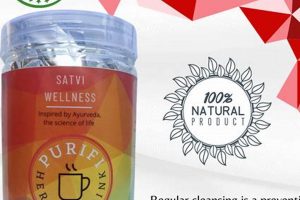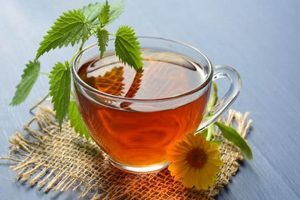The consumption of herbal infusions following oral hygiene practices warrants careful consideration. These infusions, often enjoyed for their potential health benefits and calming effects, contain various compounds that may interact with the freshly cleaned dental surfaces. Understanding these interactions is key to maintaining optimal oral health.
Timing the intake of beverages is crucial for preserving the integrity of the enamel and maximizing the effectiveness of fluoride treatments found in toothpaste. Certain herbal ingredients, even in small concentrations, can potentially stain teeth or disrupt the protective layer formed by brushing. Furthermore, the pH level of these beverages can impact the remineralization process that strengthens teeth after exposure to acids.
Subsequent sections will delve into the specific effects of herbal tea ingredients on dental health, the optimal timing for consumption relative to brushing, and recommended practices to mitigate any potential negative impacts on oral hygiene. This exploration provides valuable insights for individuals seeking to integrate herbal tea consumption into their daily routines while upholding sound oral care principles.
Considerations for Herbal Tea Consumption Post-Brushing
The following recommendations aim to provide practical guidance for integrating herbal tea consumption into an oral hygiene routine without compromising dental health.
Tip 1: Evaluate Tea Acidity: Assess the pH level of the herbal tea. Highly acidic infusions can erode enamel, diminishing the protective effects of brushing. Chamomile and certain fruit-based teas may exhibit lower pH values.
Tip 2: Delay Consumption After Brushing: Allow a minimum of 30 minutes, ideally one hour, to elapse between brushing and drinking herbal tea. This interval allows fluoride from toothpaste to effectively strengthen enamel.
Tip 3: Rinse with Water Post-Consumption: After drinking herbal tea, rinse the mouth thoroughly with plain water. This helps neutralize acids and dislodge any residual tea particles that could cause staining.
Tip 4: Monitor for Staining: Observe changes in tooth color over time. Teas containing intensely colored herbs, such as hibiscus or turmeric, have the potential to stain. Adjust consumption habits accordingly.
Tip 5: Avoid Adding Sweeteners: The addition of sugar or honey to herbal tea exacerbates the risk of tooth decay. Consume unsweetened tea to minimize potential harm to enamel.
Tip 6: Consider Straw Usage: Direct the herbal tea away from the front teeth by using a straw. This reduces contact between the beverage and the most visible areas, mitigating staining risks.
Tip 7: Prioritize Regular Dental Check-ups: Schedule regular dental examinations and cleanings. A dentist can provide personalized recommendations and identify early signs of enamel erosion or staining.
By implementing these strategies, individuals can enjoy the benefits of herbal tea while maintaining a healthy oral environment. Prudent management minimizes potential adverse effects on dental well-being.
The subsequent section will provide an overview of alternative practices that can further enhance oral health in conjunction with herbal tea consumption.
1. Tea's acidity levels
The acidity level of herbal tea directly influences the potential impact on dental enamel, particularly when consumed after brushing. Enamel, the outermost protective layer of teeth, is susceptible to erosion by acids. A lower pH, indicating higher acidity, can soften enamel, making it more vulnerable to damage. If herbal tea with a low pH is consumed shortly after brushing, when the enamel may be temporarily softened and the protective fluoride layer is still developing, the erosive effect can be amplified. For instance, hibiscus tea, known for its tartness, generally exhibits a lower pH compared to chamomile tea. This difference in acidity contributes to varying degrees of potential enamel erosion. The severity of the impact depends on both the specific acidity of the tea and the frequency of consumption.
The connection between acidity and enamel damage is well-established in dental research. Studies have shown a direct correlation between the pH of beverages and the rate of enamel erosion. Specifically, prolonged exposure to acidic substances can lead to the demineralization of enamel, a process where minerals are leached from the tooth structure. This demineralization weakens the teeth, increasing the risk of cavities and sensitivity. Consider, for example, the practice of frequently sipping acidic herbal tea throughout the day; this constant exposure to acidity may outweigh the beneficial effects of regular brushing with fluoride toothpaste, ultimately compromising dental health. Thus, knowledge of the pH of commonly consumed herbal teas is critical for mitigating the risks associated with enamel erosion.
In summary, the acidity levels present in herbal tea are a significant factor when assessing its impact on dental health, especially in the context of post-brushing consumption. Prioritizing herbal teas with neutral or slightly alkaline pH values and implementing strategies to minimize exposure to acidic beverages can significantly reduce the risk of enamel erosion. Therefore, informed choices about herbal tea selection, coupled with proper oral hygiene practices, are vital for maintaining long-term dental well-being.
2. Fluoride absorption time
Fluoride absorption time is a critical factor in oral hygiene routines, significantly influencing the efficacy of fluoride toothpaste. Following brushing, a protective layer of fluoride forms on the enamel surface, facilitating remineralization and strengthening teeth against acid attacks. Prematurely consuming herbal tea after brushing can disrupt this process, hindering optimal fluoride absorption. The acids and other compounds present in herbal tea may interfere with the fluoride ions’ ability to integrate into the enamel structure, diminishing the intended strengthening effect. If herbal tea is consumed immediately post-brushing, the protective fluoride layer may not fully develop, reducing resistance to subsequent acid exposure. For instance, a person who brushes their teeth and immediately drinks a lemon-based herbal tea potentially negates the benefits of fluoride treatment due to the acid’s interference.
The duration required for effective fluoride absorption varies but typically ranges from 30 to 60 minutes. Dental professionals recommend refraining from eating or drinking during this period to allow fluoride to adequately penetrate the enamel. Certain herbal teas, particularly those with high acidity levels or strong staining pigments, can further compromise fluoride absorption and lead to increased risk of tooth decay or discoloration if consumed too soon after brushing. Conversely, allowing adequate time for fluoride absorption maximizes its protective capabilities. This allows for a greater concentration of fluoride ions to bond with the enamel, creating a stronger and more acid-resistant surface. Prioritizing this waiting period can significantly enhance the long-term effectiveness of fluoride toothpaste.
In conclusion, the timing of herbal tea consumption relative to brushing plays a pivotal role in optimizing fluoride absorption. Adhering to a recommended waiting period after brushing ensures that fluoride can effectively strengthen enamel and provide adequate protection against acids. This conscious decision to delay drinking herbal tea post-brushing represents a proactive step in maintaining long-term oral health and mitigating potential detrimental effects. This practice is particularly important for individuals who frequently consume herbal teas or those with heightened susceptibility to dental decay.
3. Potential teeth staining
The likelihood of tooth discoloration following the consumption of herbal tea after brushing is a tangible concern. Certain herbal infusions possess chromogenic compounds capable of adhering to the dental enamel, leading to extrinsic staining. Understanding the factors influencing this phenomenon is essential for informed oral care.
- Chromogen Concentration
The concentration of chromogens, or color-producing substances, within the herbal tea directly correlates with the staining potential. Teas containing high levels of tannins or other pigments, such as hibiscus or turmeric-based blends, present a greater risk of discoloration. Frequent consumption of these intensely colored infusions can lead to gradual staining, particularly if proper oral hygiene is not diligently maintained.
- Enamel Porosity
The structural integrity of dental enamel influences its susceptibility to staining. Enamel with increased porosity, often resulting from erosion or demineralization, provides more surface area for chromogens to adhere to. Consuming herbal tea, especially after brushing when the enamel might be temporarily softened, can exacerbate staining in individuals with compromised enamel.
- Salivary Flow Rate
Saliva plays a crucial role in clearing oral debris and buffering acids, thereby mitigating staining. Reduced salivary flow, whether due to medications, medical conditions, or dehydration, can prolong the contact time between chromogens and enamel, increasing the likelihood of discoloration. Individuals with diminished salivary function are therefore more vulnerable to staining from herbal tea consumption.
- Post-Brushing Interval
The time elapsed between brushing and consuming herbal tea impacts the risk of staining. Brushing removes surface stains and plaque, creating a clean enamel surface. However, if herbal tea is consumed immediately after brushing, the chromogens have a greater opportunity to bind to the freshly cleaned enamel before the protective salivary pellicle reforms. Delaying tea consumption allows the pellicle to provide a barrier against staining agents.
These factors underscore the complex interplay between herbal tea ingredients and the dental environment. Although the consumption of certain herbal teas offers various health benefits, understanding and managing the potential for tooth staining is integral to maintaining both oral health and aesthetic appearance. Implementing preventive measures, such as rinsing with water after tea consumption and maintaining optimal hydration, can minimize the risk of discoloration.
4. Enamel erosion risks
Enamel erosion, the irreversible loss of tooth enamel, is a significant dental concern exacerbated by dietary habits, including the consumption of herbal tea, particularly after brushing. The correlation between enamel erosion risks and herbal tea consumption hinges on several critical factors that impact the integrity of the tooth surface.
- Acidity of Herbal Teas
Many herbal teas possess acidic properties due to their inherent chemical composition. Acids can demineralize enamel, weakening its structure and making it more susceptible to erosion. The severity of erosion is directly related to the pH level of the tea and the duration of exposure. For example, herbal teas containing citric acid or malic acid exhibit a higher erosive potential compared to those with a neutral pH.
- Timing Relative to Brushing
Brushing teeth, while essential for oral hygiene, can temporarily soften enamel, especially when using abrasive toothpastes. Consuming acidic herbal tea immediately after brushing amplifies the risk of erosion because the enamel is more vulnerable during this period. Delaying tea consumption allows the enamel to reharden through remineralization facilitated by saliva and fluoride.
- Frequency of Consumption
Frequent consumption of herbal teas, even those with moderate acidity, poses a cumulative risk to enamel. Repeated acid exposure over time leads to progressive demineralization and erosion. Individuals who habitually sip herbal tea throughout the day subject their teeth to prolonged acidic challenges, increasing the likelihood of enamel damage. A limited consumption pattern with fewer exposures reduces overall risk.
- Salivary Flow
Saliva plays a crucial role in buffering acids and promoting remineralization. Reduced salivary flow, caused by medications, medical conditions, or dehydration, diminishes the protective capacity of saliva and increases the vulnerability to enamel erosion. Individuals with compromised salivary function are at greater risk from the acidic effects of herbal tea consumption. Stimulation of salivary flow, such as through chewing sugar-free gum, can help counteract this effect.
These facets collectively underscore the importance of considering the erosive potential of herbal tea, particularly in relation to oral hygiene practices. Prudent management of these factorsnamely, selecting less acidic teas, delaying consumption after brushing, limiting frequency, and maintaining adequate salivary flowis essential for mitigating the risks of enamel erosion. Furthermore, individuals should seek professional dental advice to assess their specific risk profile and implement appropriate preventive strategies.
5. Saliva's neutralizing action
Saliva’s physiological function in neutralizing acids within the oral cavity significantly influences the impact of consuming herbal tea after brushing. Its capacity to buffer acidic challenges directly affects the potential for enamel erosion and overall dental health.
- Bicarbonate Buffering System
Saliva contains bicarbonate ions, which act as a primary buffer against acids. This system neutralizes the pH of acidic substances, such as herbal teas, mitigating their erosive potential on enamel. The effectiveness of this buffering system is influenced by the salivary flow rate and the concentration of bicarbonate present. For example, a higher salivary flow rate allows for more rapid and efficient neutralization of acids after herbal tea consumption.
- Pellicle Formation
Saliva contributes to the formation of the acquired pellicle, a protective protein layer on the enamel surface. This pellicle acts as a barrier, reducing the direct contact between acids in herbal tea and the enamel. The integrity and thickness of the pellicle affect its ability to shield the enamel from erosive damage. A well-formed pellicle provides a crucial line of defense against the acidic challenges posed by herbal tea consumption after brushing.
- Remineralization Promotion
Saliva is supersaturated with calcium and phosphate ions, essential minerals for enamel remineralization. After an acidic attack from herbal tea, saliva facilitates the redeposition of these minerals onto the enamel surface, repairing minor damage and strengthening the tooth structure. The efficiency of remineralization depends on the availability of these minerals in saliva and the pH of the oral environment. Promoting salivary flow after herbal tea consumption enhances this natural repair process.
- Clearance of Food Debris
Saliva’s flushing action aids in clearing food particles and residual herbal tea from the oral cavity. This reduces the duration of acid exposure to the enamel. A higher salivary flow rate ensures quicker removal of debris, minimizing the risk of prolonged acidic contact. The mechanical action of swallowing further assists in this clearance process.
These facets highlight the multifaceted role of saliva in mitigating the adverse effects of herbal tea consumption on dental health, particularly following brushing. Its buffering capacity, pellicle formation, remineralization promotion, and debris clearance mechanisms work synergistically to protect enamel from erosion and maintain oral homeostasis. Understanding and promoting these natural protective functions of saliva is crucial for individuals who regularly consume herbal tea, especially in the context of post-brushing routines.
6. Sweetener's added impact
The incorporation of sweeteners into herbal tea, particularly when consumed after brushing teeth, significantly alters the oral environment and introduces heightened risks to dental health. The addition of sugars and other sweeteners transforms a potentially neutral or slightly acidic beverage into a cariogenic substrate, demanding careful consideration within oral hygiene practices.
- Elevated Cariogenic Potential
Sweeteners, such as sucrose, fructose, and glucose, serve as readily available substrates for oral bacteria. These bacteria metabolize sugars, producing acids as a byproduct. The resulting acidic environment demineralizes tooth enamel, initiating the process of dental caries. Consuming sweetened herbal tea after brushing provides a direct source of fermentable carbohydrates, increasing the risk of cavity formation, particularly if brushing efficacy is compromised or salivary flow is reduced.
- Biofilm Formation Enhancement
The presence of sweeteners promotes the formation and adhesion of dental plaque biofilm on tooth surfaces. Sugars increase the stickiness of the biofilm, facilitating the colonization of cariogenic bacteria. This enhanced biofilm creates a localized acidic environment, prolonging the demineralization process. Consuming sweetened herbal tea immediately after brushing allows these bacteria to rapidly colonize the freshly cleaned enamel, increasing their cariogenic potential.
- pH Reduction and Prolonged Acidity
Sweeteners contribute to a significant reduction in oral pH, creating an environment conducive to enamel erosion. The prolonged presence of sugars in the oral cavity extends the duration of this acidic challenge, increasing the risk of demineralization. Unlike unsweetened herbal teas, which may have a relatively short-lived impact on oral pH, sweetened varieties maintain an acidic environment for an extended period, exacerbating the erosive effects.
- Interference with Fluoride Action
The presence of sweeteners can interfere with the remineralizing effects of fluoride found in toothpaste. The acidic environment created by sugar metabolism hinders the incorporation of fluoride ions into the enamel structure. This compromised fluoride action reduces the enamel’s resistance to acid attacks, increasing susceptibility to caries. Therefore, the consumption of sweetened herbal tea after brushing can negate the benefits of fluoride treatment, diminishing its protective effect.
These aspects underscore the detrimental impact of sweeteners on dental health when incorporated into herbal tea, particularly when consumed after brushing. The elevated cariogenic potential, enhanced biofilm formation, pH reduction, and interference with fluoride action collectively increase the risk of dental caries and enamel erosion. Prudent avoidance of sweeteners or implementation of rigorous oral hygiene practices is essential for mitigating these risks and preserving long-term dental well-being.
7. Rinsing after drinking
The practice of rinsing after drinking herbal tea is a pertinent consideration when assessing the overall impact of beverage consumption on oral health, particularly in the context of consuming herbal tea following tooth brushing. This simple act can significantly influence the oral environment and mitigate potential adverse effects.
- Neutralization of Acids
Rinsing with water after drinking herbal tea helps neutralize any residual acids present in the oral cavity. Many herbal teas, regardless of their perceived mildness, possess acidic properties that can contribute to enamel erosion. Rinsing dilutes these acids and reduces their contact time with the tooth surface, diminishing their erosive potential. For instance, if hibiscus tea, known for its tartness, is consumed, rinsing with water immediately afterward helps remove lingering citric acid.
- Removal of Staining Agents
Certain herbal teas contain chromogenic compounds that can stain teeth over time. Rinsing with water can dislodge these staining agents before they have an opportunity to fully adhere to the enamel. This is particularly important for teas with dark pigments, such as those containing berries or dark herbs. For example, rinsing after drinking a strongly colored berry tea can significantly reduce the risk of discoloration.
- Clearance of Sugar Residue
If herbal tea is sweetened, rinsing helps remove residual sugar from the oral cavity. Sugars provide a substrate for bacteria to produce acids, leading to tooth decay. Rinsing minimizes the availability of these sugars, reducing the risk of caries formation. This is crucial even with natural sweeteners like honey, which can still contribute to bacterial activity.
- Promotion of Salivary Flow
Rinsing with water can stimulate salivary flow. Saliva acts as a natural buffer, neutralizing acids and promoting remineralization. Increased salivary flow after drinking herbal tea helps restore the oral pH balance and protect the enamel. This effect is particularly beneficial for individuals with reduced salivary function.
In conclusion, rinsing with water following herbal tea consumption represents a practical and effective strategy for mitigating potential negative impacts on dental health. When considered in the context of consuming herbal tea after brushing, rinsing becomes even more important, as it assists in removing residual acids, staining agents, and sugars while promoting salivary flow, thereby enhancing the protective effects of brushing.
Frequently Asked Questions
This section addresses common inquiries regarding the consumption of herbal tea in relation to oral hygiene practices, specifically after brushing teeth. The aim is to provide evidence-based information to guide informed decisions concerning dental health.
Question 1: Does herbal tea erode tooth enamel?
Herbal tea may erode tooth enamel due to its acidic properties. The extent of erosion depends on the specific tea’s pH level and the frequency of consumption. Teas with higher acidity pose a greater risk to enamel integrity.
Question 2: How long should one wait after brushing before drinking herbal tea?
A minimum of 30 minutes, ideally one hour, is recommended between brushing and consuming herbal tea. This allows fluoride from toothpaste sufficient time to strengthen enamel and provide protection against acids.
Question 3: Does rinsing with water after drinking herbal tea mitigate staining risks?
Rinsing with water after herbal tea consumption helps remove residual pigments and acids, reducing the potential for staining. This practice assists in minimizing contact time between staining agents and enamel.
Question 4: Do sweeteners in herbal tea impact dental health after brushing?
Sweeteners, including sugar and honey, increase the risk of tooth decay. Bacteria metabolize sugars, producing acids that erode enamel. The use of sweeteners should be minimized or avoided, particularly after brushing.
Question 5: Is the timing of herbal tea consumption more critical than the type of herbal tea?
Both the timing of consumption and the type of herbal tea are significant factors. Acidic teas consumed immediately after brushing pose the highest risk. However, even less acidic teas consumed frequently can contribute to enamel erosion over time.
Question 6: What are the long-term effects of frequently drinking herbal tea after brushing?
Frequent consumption of herbal tea after brushing can lead to enamel erosion, tooth decay, and staining. These effects can compromise overall dental health and necessitate restorative treatments.
In summary, prudent timing, informed beverage selection, and meticulous oral hygiene practices are crucial for mitigating potential risks associated with herbal tea consumption following brushing.
The following section explores alternative beverages and their relative impact on dental health.
Can You Drink Herbal Tea After Brushing Teeth
The preceding analysis has elucidated the complex relationship between the consumption of herbal tea and oral hygiene practices centered around toothbrushing. Key considerations encompass the tea’s acidity, fluoride absorption time, potential for staining, and the mitigating role of saliva. Ignoring these factors can compromise dental health, leading to enamel erosion, increased caries risk, and aesthetic concerns.
Therefore, a judicious approach is warranted. Individuals who prioritize oral health should carefully consider the timing of herbal tea consumption relative to brushing, opting for a delay to maximize fluoride’s protective effects. Furthermore, informed choices regarding tea selection, minimizing sweeteners, and consistent rinsing practices are essential. These proactive measures contribute to long-term dental well-being.







